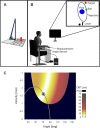Brain negativity as an indicator of predictive error processing: the contribution of visual action effect monitoring
- PMID: 28446578
- PMCID: PMC5506263
- DOI: 10.1152/jn.00036.2017
Brain negativity as an indicator of predictive error processing: the contribution of visual action effect monitoring
Abstract
The error (related) negativity (Ne/ERN) is an event-related potential in the electroencephalogram (EEG) correlating with error processing. Its conditions of appearance before terminal external error information suggest that the Ne/ERN is indicative of predictive processes in the evaluation of errors. The aim of the present study was to specifically examine the Ne/ERN in a complex motor task and to particularly rule out other explaining sources of the Ne/ERN aside from error prediction processes. To this end, we focused on the dependency of the Ne/ERN on visual monitoring about the action outcome after movement termination but before result feedback (action effect monitoring). Participants performed a semi-virtual throwing task by using a manipulandum to throw a virtual ball displayed on a computer screen to hit a target object. Visual feedback about the ball flying to the target was masked to prevent action effect monitoring. Participants received a static feedback about the action outcome (850 ms) after each trial. We found a significant negative deflection in the average EEG curves of the error trials peaking at ~250 ms after ball release, i.e., before error feedback. Furthermore, this Ne/ERN signal did not depend on visual ball-flight monitoring after release. We conclude that the Ne/ERN has the potential to indicate error prediction in motor tasks and that it exists even in the absence of action effect monitoring.NEW & NOTEWORTHY In this study, we are separating different kinds of possible contributors to an electroencephalogram (EEG) error correlate (Ne/ERN) in a throwing task. We tested the influence of action effect monitoring on the Ne/ERN amplitude in the EEG. We used a task that allows us to restrict movement correction and action effect monitoring and to control the onset of result feedback. We ascribe the Ne/ERN to predictive error processing where a conscious feeling of failure is not a prerequisite.
Keywords: EEG; ERP; action effect monitoring; error negativity; forward model.
Copyright © 2017 the American Physiological Society.
Figures







Similar articles
-
Accuracy of Motor Error Predictions for Different Sensory Signals.Front Psychol. 2018 Aug 7;9:1376. doi: 10.3389/fpsyg.2018.01376. eCollection 2018. Front Psychol. 2018. PMID: 30131740 Free PMC article.
-
Neural correlates of error prediction in a complex motor task.Front Behav Neurosci. 2015 Aug 5;9:209. doi: 10.3389/fnbeh.2015.00209. eCollection 2015. Front Behav Neurosci. 2015. PMID: 26300754 Free PMC article.
-
Error significance but not error expectancy predicts error-related negativities for different error types.Behav Brain Res. 2016 Jan 15;297:259-67. doi: 10.1016/j.bbr.2015.10.031. Epub 2015 Oct 23. Behav Brain Res. 2016. PMID: 26481402
-
Updating the relationship of the Ne/ERN to task-related behavior: A brief review and suggestions for future research.Front Hum Neurosci. 2023 Apr 4;17:1150244. doi: 10.3389/fnhum.2023.1150244. eCollection 2023. Front Hum Neurosci. 2023. PMID: 37082151 Free PMC article. Review.
-
Action-Monitoring Alterations as Indicators of Predictive Deficits in Schizophrenia.Top Cogn Sci. 2021 Jan;13(1):142-163. doi: 10.1111/tops.12495. Epub 2020 Mar 5. Top Cogn Sci. 2021. PMID: 32134559 Review.
Cited by
-
Focused Review on Neural Correlates of Different Types of Motor Errors and Related Terminological Issues.J Hum Kinet. 2021 Jan 29;76:67-81. doi: 10.2478/hukin-2020-0087. eCollection 2021 Jan. J Hum Kinet. 2021. PMID: 33603925 Free PMC article.
-
Temporal Fluctuation of Mood in Gaming Task Modulates Feedback Negativity: EEG Study With Virtual Reality.Front Hum Neurosci. 2021 Jun 3;15:536288. doi: 10.3389/fnhum.2021.536288. eCollection 2021. Front Hum Neurosci. 2021. PMID: 34149374 Free PMC article.
-
Accuracy of Motor Error Predictions for Different Sensory Signals.Front Psychol. 2018 Aug 7;9:1376. doi: 10.3389/fpsyg.2018.01376. eCollection 2018. Front Psychol. 2018. PMID: 30131740 Free PMC article.
-
Combined EEG and immersive virtual reality unveil dopaminergic modulation of error monitoring in Parkinson's Disease.NPJ Parkinsons Dis. 2023 Jan 13;9(1):3. doi: 10.1038/s41531-022-00441-5. NPJ Parkinsons Dis. 2023. PMID: 36639384 Free PMC article.
-
Error-related negativity predicts failure in competitive dual-player video games.PLoS One. 2019 Feb 28;14(2):e0212483. doi: 10.1371/journal.pone.0212483. eCollection 2019. PLoS One. 2019. PMID: 30818382 Free PMC article.
References
Publication types
MeSH terms
LinkOut - more resources
Full Text Sources
Other Literature Sources

